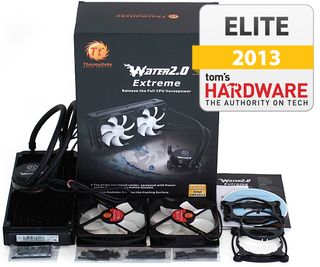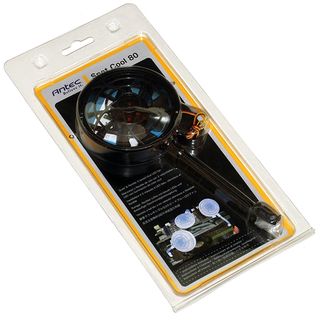System Builder Marathon, Q1 2014: The $2400 People’s Choice PC
CPU And Motherboard Cooling

Processors based on Intel's Haswell architecture can be much more difficult to cool than Ivy Bridge-E. Meanwhile, the Haswell design need less absolute cooling capacity than Ivy Bridge-E. Those two apparently-conflicting statements can be justified by the observation that the lower-power Haswell-based chips respond poorly to increased cooling capacity.
CPU Cooling: Thermaltake Water 2.0 Extreme
Given the above observations, it appears that anything larger than a 120 mm single-fan cooling tower wastes money. On the other hand, choosing anything smaller than the cooler from my previous build would open me up to criticism if today's setup didn't overclock well. I wanted to play this one safe.


Read Customer Reviews of Thermaltake's Water 2.0 Extreme
Overclocked Haswell cores are so temperamental that a mere 3 °C drop in temperature can add 100 MHz to a stable configuration. Because of the CPU’s heat transfer problems, that’s about all I expect from Thermaltake’s huge, award-winning Water 2.0 Extreme.
Motherboard Cooling: Antec SpotCool 80
Anyone who thinks that $95 is too much to spend to cool a heat-soaked CPU will be incensed to hear that the expense doesn’t end there. Most motherboards are designed to cool the CPU voltage regulator using exhaust from the CPU cooler, and the fans on a liquid cooler's radiator don’t point in that direction.


Read Customer Reviews of Antec's SpotCool 80
Designed to cool nearly any component, Antec’s SpotCool is the perfect add-on voltage regulator fan for motherboards that weren’t designed to accept a fan. I always keep one of these on-hand for liquid-cooling predicaments, but decided to actually include it in my order this time.
The need for a voltage regulator fan emerges at moderately increased CPU voltage. If the CPU isn’t able to support moderate voltage increases before crossing its own thermal threshold, then I’ve wasted money.
Current page: CPU And Motherboard Cooling
Prev Page Motherboard, Case, And Power Next Page An Alphabet Soup Of Storage: SSD, HDD, And ODDStay on the Cutting Edge
Join the experts who read Tom's Hardware for the inside track on enthusiast PC tech news — and have for over 25 years. We'll send breaking news and in-depth reviews of CPUs, GPUs, AI, maker hardware and more straight to your inbox.
-
Darkerson Interesting move, showing the nicest build 1st instead of last. Cant wait to see all the builds compared and see what you all come up with as the budget goes down.Reply -
captain_jonno Looks good. Surprised only went with a 750w PSU though. Considering 2x 780 ti's and overlockingReply -
Crashman Reply
Yessir, two 780s and a bit of experience in part picking lead me to expect around 700W of required system power. And, it came out just a little less than 700W.12951919 said:Looks good. Surprised only went with a 750w PSU though. Considering 2x 780 ti's and overlocking
Power supplies of greater capacity and similar reliability at this price tend to be lower-efficiency units. And we like efficiency too.
-
Crashman Reply
It's not calculated power, it's measured power for the entire system (at the power plug). No addition or subtraction was used.12952008 said:I dont get the "W" usage?680+237 = 917w. Not 802w as meation above?
1.) Start the system, wait for all processes to load, take a measurement (Active, but idle)
2.) Load the CPU using eight thread of AVX-optimized Prime95, take a reading (CPU Load).
3.) Load GPUs with 3DMark 11 Test 1 in loop, take max reading as it heats up (GPU Load).
4.) Load both applications (CPU+GPU Load).
The "math problem" is that any program used to fully load the GPU also partly loads the CPU. So when test 4 is Prime95+3DMark, Prime95 can only use whatever CPU resources are left with 3DMark running.
So the most accurate system power reading is with "CPU+GPU Load" applied. The system measurement for "CPU Load" still includes the power of an idle GPU. And the system power measurement for "GPU Load" still includes the amount of CPU energy it takes to run the GPU's test application.
-
YellowBee Reply12952046 said:
It's not a calculation, it's a reading for the entire system (at the power plug). Load the CPU using eight thread of AVX-optimized Prime95, take reading one. Load GPUs with 3DMark 11 Test 1 in loop, take max reading as it heats up.12952008 said:I dont get the "W" usage?680+237 = 917w. Not 802w as meation above?
The "math problem" is that any program used to fully load the GPU also partly loads the CPU. So when test 3 is Prime95+3DMark, Prime95 can only use whatever CPU resources are left with 3DMark running.
So the most accurate system power reading is with "CPU+GPU Load" applied. The system measurement for "CPU Load" still includes the reading of an idle GPU. And the system power measurement for "GPU Load" still includes the amount of CPU power it takes to run the GPU.
Very much appreciated and satisfying answer.
Thanks Crashman :) -
bemused_fred Reply
Any chance of including these calculations in all future articles, so that we know exactly how the power graph is calculated? Ta.
It's not calculated power, it's measured power for the entire system (at the power plug). No addition or subtraction was used.1.) Start the system, wait for all processes to load, take a measurement (Active, but idle)2.) Load the CPU using eight thread of AVX-optimized Prime95, take a reading (CPU Load).3.) Load GPUs with 3DMark 11 Test 1 in loop, take max reading as it heats up (GPU Load).4.) Load both applications (CPU+GPU Load).The "math problem" is that any program used to fully load the GPU also partly loads the CPU. So when test 4 is Prime95+3DMark, Prime95 can only use whatever CPU resources are left with 3DMark running.So the most accurate system power reading is with "CPU+GPU Load" applied. The system measurement for "CPU Load" still includes the power of an idle GPU. And the system power measurement for "GPU Load" still includes the amount of CPU energy it takes to run the GPU's test application.12952008 said:I dont get the "W" usage?680+237 = 917w. Not 802w as meation above? -
Crashman Reply
Which calculations?12952271 said:
Any chance of including these calculations in all future articles, so that we know exactly how the power graph is calculated? Ta.12952046 said:It's not calculated power, it's measured power for the entire system
-
jabuscus wow. such performance. many ram. they should've put in 16gb of ram for real high-end specs. ;)Reply -
Versutia As I'm into quiet enclosures, I'd go along this route:Reply
http://pcpartpicker.com/p/3fuGw
Wondering how much of a difference would non-reference cards make. Obviously, CPU cooler and RAM could be different, BR drive optional, storage drive as well.

